INDU 1033 - Managing Across Cultures Report: Global Management
VerifiedAdded on 2022/09/02
|13
|4367
|18
Report
AI Summary
This report, focusing on 'Managing Across Cultures,' begins with a cultural interview and personal profile, exploring cultural dimensions through the lens of Hofstede's theory, and reflecting on personal experiences using the Gibbs model. The report then analyzes a case study on cultural management in global organizations, highlighting the challenges faced by global managers in navigating diverse cultural environments. It examines the impact of cultural and organizational environments on management practices, emphasizing the importance of cultural awareness for effective communication and team dynamics. The report provides insights into the challenges and responsibilities of global managers, offering strategies to foster a positive working culture and overcome cultural disparities within multinational organizations. The report emphasizes the significance of understanding and adapting to diverse cultural norms to ensure the success of global operations and organizational goals. The report concludes with a reflection on the complexities of cross-cultural management and the importance of developing cultural sensitivity and awareness.
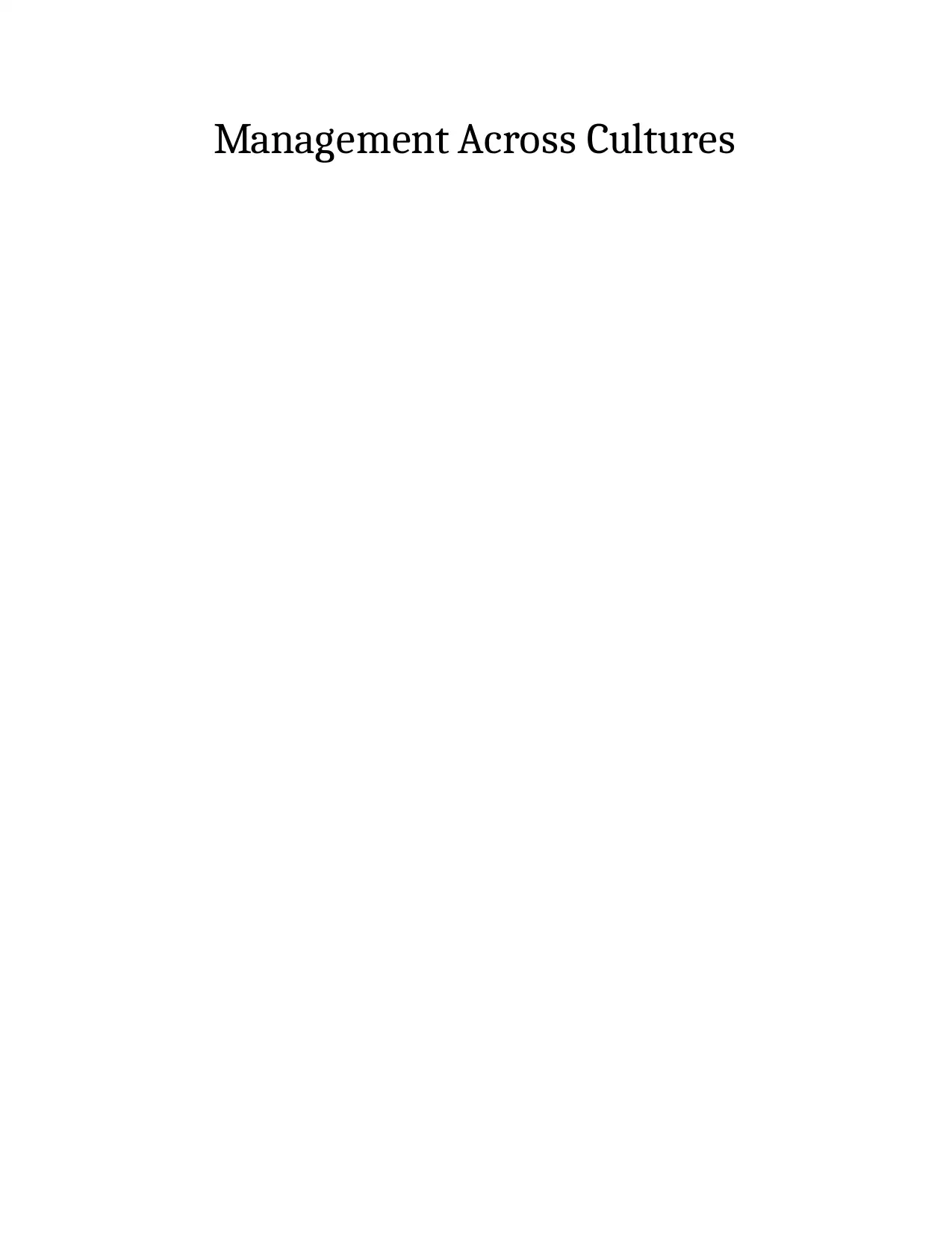
Management Across Cultures
Paraphrase This Document
Need a fresh take? Get an instant paraphrase of this document with our AI Paraphraser
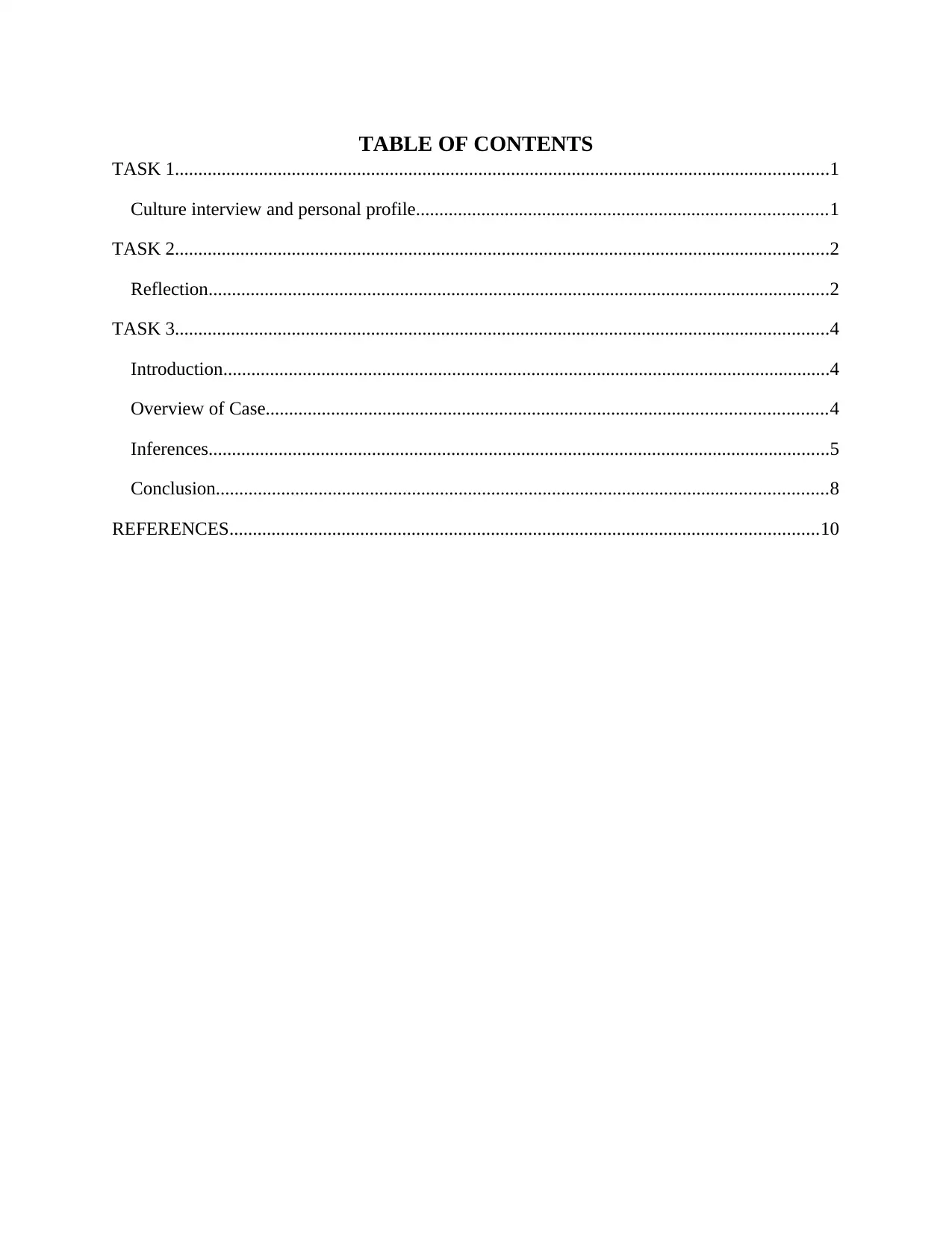
TABLE OF CONTENTS
TASK 1............................................................................................................................................1
Culture interview and personal profile........................................................................................1
TASK 2............................................................................................................................................2
Reflection.....................................................................................................................................2
TASK 3............................................................................................................................................4
Introduction..................................................................................................................................4
Overview of Case........................................................................................................................4
Inferences.....................................................................................................................................5
Conclusion...................................................................................................................................8
REFERENCES..............................................................................................................................10
TASK 1............................................................................................................................................1
Culture interview and personal profile........................................................................................1
TASK 2............................................................................................................................................2
Reflection.....................................................................................................................................2
TASK 3............................................................................................................................................4
Introduction..................................................................................................................................4
Overview of Case........................................................................................................................4
Inferences.....................................................................................................................................5
Conclusion...................................................................................................................................8
REFERENCES..............................................................................................................................10
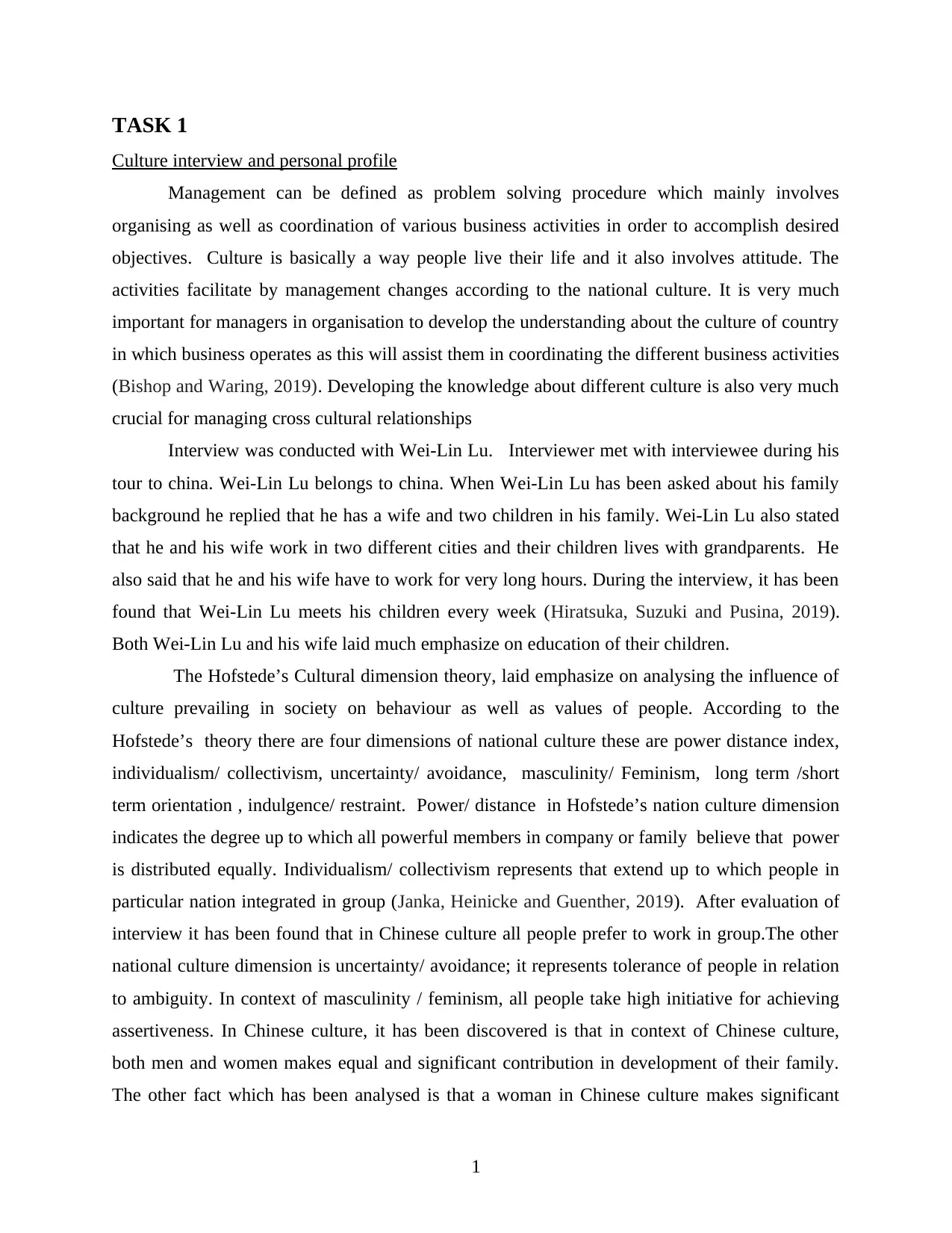
TASK 1
Culture interview and personal profile
Management can be defined as problem solving procedure which mainly involves
organising as well as coordination of various business activities in order to accomplish desired
objectives. Culture is basically a way people live their life and it also involves attitude. The
activities facilitate by management changes according to the national culture. It is very much
important for managers in organisation to develop the understanding about the culture of country
in which business operates as this will assist them in coordinating the different business activities
(Bishop and Waring, 2019). Developing the knowledge about different culture is also very much
crucial for managing cross cultural relationships
Interview was conducted with Wei-Lin Lu. Interviewer met with interviewee during his
tour to china. Wei-Lin Lu belongs to china. When Wei-Lin Lu has been asked about his family
background he replied that he has a wife and two children in his family. Wei-Lin Lu also stated
that he and his wife work in two different cities and their children lives with grandparents. He
also said that he and his wife have to work for very long hours. During the interview, it has been
found that Wei-Lin Lu meets his children every week (Hiratsuka, Suzuki and Pusina, 2019).
Both Wei-Lin Lu and his wife laid much emphasize on education of their children.
The Hofstede’s Cultural dimension theory, laid emphasize on analysing the influence of
culture prevailing in society on behaviour as well as values of people. According to the
Hofstede’s theory there are four dimensions of national culture these are power distance index,
individualism/ collectivism, uncertainty/ avoidance, masculinity/ Feminism, long term /short
term orientation , indulgence/ restraint. Power/ distance in Hofstede’s nation culture dimension
indicates the degree up to which all powerful members in company or family believe that power
is distributed equally. Individualism/ collectivism represents that extend up to which people in
particular nation integrated in group (Janka, Heinicke and Guenther, 2019). After evaluation of
interview it has been found that in Chinese culture all people prefer to work in group.The other
national culture dimension is uncertainty/ avoidance; it represents tolerance of people in relation
to ambiguity. In context of masculinity / feminism, all people take high initiative for achieving
assertiveness. In Chinese culture, it has been discovered is that in context of Chinese culture,
both men and women makes equal and significant contribution in development of their family.
The other fact which has been analysed is that a woman in Chinese culture makes significant
1
Culture interview and personal profile
Management can be defined as problem solving procedure which mainly involves
organising as well as coordination of various business activities in order to accomplish desired
objectives. Culture is basically a way people live their life and it also involves attitude. The
activities facilitate by management changes according to the national culture. It is very much
important for managers in organisation to develop the understanding about the culture of country
in which business operates as this will assist them in coordinating the different business activities
(Bishop and Waring, 2019). Developing the knowledge about different culture is also very much
crucial for managing cross cultural relationships
Interview was conducted with Wei-Lin Lu. Interviewer met with interviewee during his
tour to china. Wei-Lin Lu belongs to china. When Wei-Lin Lu has been asked about his family
background he replied that he has a wife and two children in his family. Wei-Lin Lu also stated
that he and his wife work in two different cities and their children lives with grandparents. He
also said that he and his wife have to work for very long hours. During the interview, it has been
found that Wei-Lin Lu meets his children every week (Hiratsuka, Suzuki and Pusina, 2019).
Both Wei-Lin Lu and his wife laid much emphasize on education of their children.
The Hofstede’s Cultural dimension theory, laid emphasize on analysing the influence of
culture prevailing in society on behaviour as well as values of people. According to the
Hofstede’s theory there are four dimensions of national culture these are power distance index,
individualism/ collectivism, uncertainty/ avoidance, masculinity/ Feminism, long term /short
term orientation , indulgence/ restraint. Power/ distance in Hofstede’s nation culture dimension
indicates the degree up to which all powerful members in company or family believe that power
is distributed equally. Individualism/ collectivism represents that extend up to which people in
particular nation integrated in group (Janka, Heinicke and Guenther, 2019). After evaluation of
interview it has been found that in Chinese culture all people prefer to work in group.The other
national culture dimension is uncertainty/ avoidance; it represents tolerance of people in relation
to ambiguity. In context of masculinity / feminism, all people take high initiative for achieving
assertiveness. In Chinese culture, it has been discovered is that in context of Chinese culture,
both men and women makes equal and significant contribution in development of their family.
The other fact which has been analysed is that a woman in Chinese culture makes significant
1
⊘ This is a preview!⊘
Do you want full access?
Subscribe today to unlock all pages.

Trusted by 1+ million students worldwide
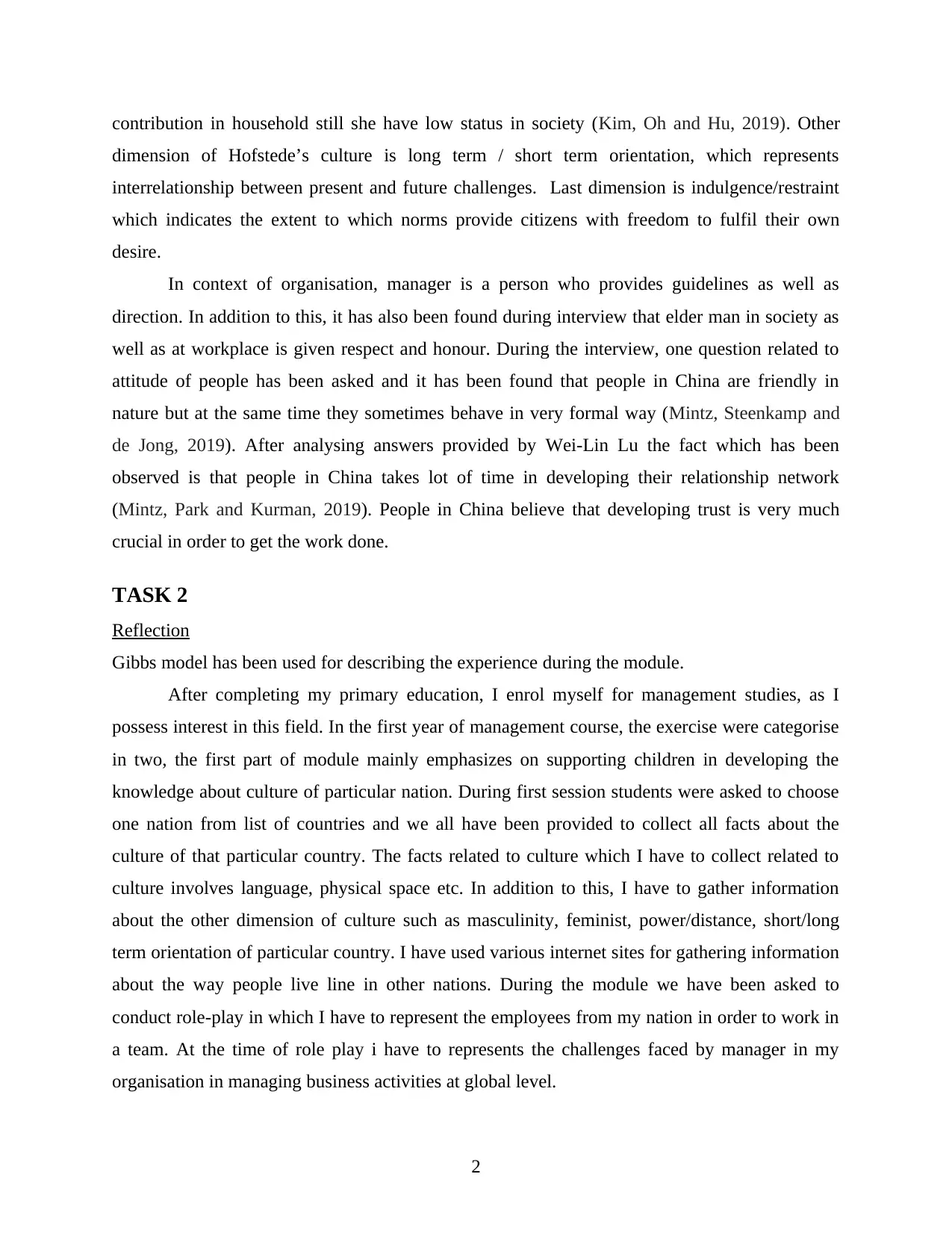
contribution in household still she have low status in society (Kim, Oh and Hu, 2019). Other
dimension of Hofstede’s culture is long term / short term orientation, which represents
interrelationship between present and future challenges. Last dimension is indulgence/restraint
which indicates the extent to which norms provide citizens with freedom to fulfil their own
desire.
In context of organisation, manager is a person who provides guidelines as well as
direction. In addition to this, it has also been found during interview that elder man in society as
well as at workplace is given respect and honour. During the interview, one question related to
attitude of people has been asked and it has been found that people in China are friendly in
nature but at the same time they sometimes behave in very formal way (Mintz, Steenkamp and
de Jong, 2019). After analysing answers provided by Wei-Lin Lu the fact which has been
observed is that people in China takes lot of time in developing their relationship network
(Mintz, Park and Kurman, 2019). People in China believe that developing trust is very much
crucial in order to get the work done.
TASK 2
Reflection
Gibbs model has been used for describing the experience during the module.
After completing my primary education, I enrol myself for management studies, as I
possess interest in this field. In the first year of management course, the exercise were categorise
in two, the first part of module mainly emphasizes on supporting children in developing the
knowledge about culture of particular nation. During first session students were asked to choose
one nation from list of countries and we all have been provided to collect all facts about the
culture of that particular country. The facts related to culture which I have to collect related to
culture involves language, physical space etc. In addition to this, I have to gather information
about the other dimension of culture such as masculinity, feminist, power/distance, short/long
term orientation of particular country. I have used various internet sites for gathering information
about the way people live line in other nations. During the module we have been asked to
conduct role-play in which I have to represent the employees from my nation in order to work in
a team. At the time of role play i have to represents the challenges faced by manager in my
organisation in managing business activities at global level.
2
dimension of Hofstede’s culture is long term / short term orientation, which represents
interrelationship between present and future challenges. Last dimension is indulgence/restraint
which indicates the extent to which norms provide citizens with freedom to fulfil their own
desire.
In context of organisation, manager is a person who provides guidelines as well as
direction. In addition to this, it has also been found during interview that elder man in society as
well as at workplace is given respect and honour. During the interview, one question related to
attitude of people has been asked and it has been found that people in China are friendly in
nature but at the same time they sometimes behave in very formal way (Mintz, Steenkamp and
de Jong, 2019). After analysing answers provided by Wei-Lin Lu the fact which has been
observed is that people in China takes lot of time in developing their relationship network
(Mintz, Park and Kurman, 2019). People in China believe that developing trust is very much
crucial in order to get the work done.
TASK 2
Reflection
Gibbs model has been used for describing the experience during the module.
After completing my primary education, I enrol myself for management studies, as I
possess interest in this field. In the first year of management course, the exercise were categorise
in two, the first part of module mainly emphasizes on supporting children in developing the
knowledge about culture of particular nation. During first session students were asked to choose
one nation from list of countries and we all have been provided to collect all facts about the
culture of that particular country. The facts related to culture which I have to collect related to
culture involves language, physical space etc. In addition to this, I have to gather information
about the other dimension of culture such as masculinity, feminist, power/distance, short/long
term orientation of particular country. I have used various internet sites for gathering information
about the way people live line in other nations. During the module we have been asked to
conduct role-play in which I have to represent the employees from my nation in order to work in
a team. At the time of role play i have to represents the challenges faced by manager in my
organisation in managing business activities at global level.
2
Paraphrase This Document
Need a fresh take? Get an instant paraphrase of this document with our AI Paraphraser
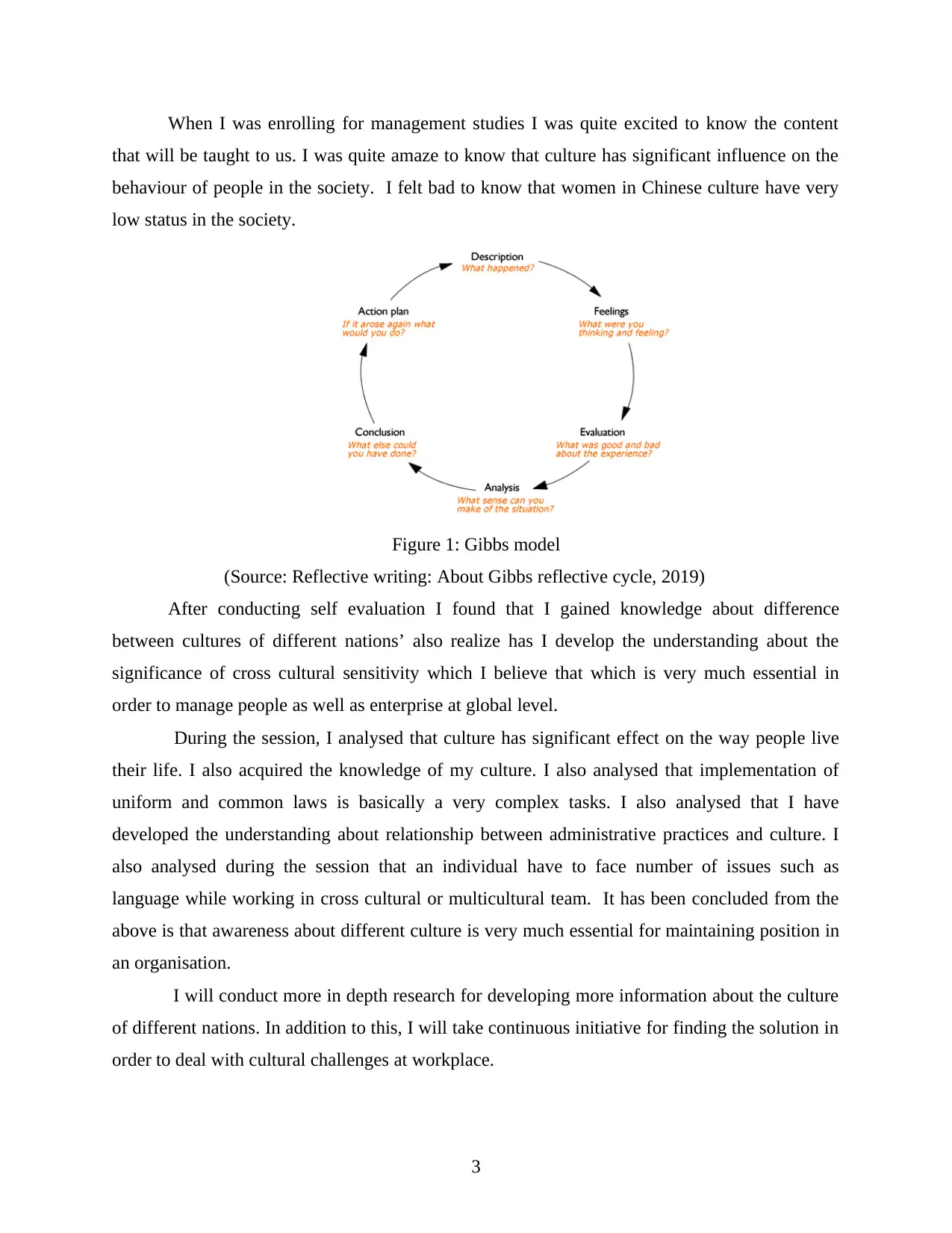
When I was enrolling for management studies I was quite excited to know the content
that will be taught to us. I was quite amaze to know that culture has significant influence on the
behaviour of people in the society. I felt bad to know that women in Chinese culture have very
low status in the society.
Figure 1: Gibbs model
(Source: Reflective writing: About Gibbs reflective cycle, 2019)
After conducting self evaluation I found that I gained knowledge about difference
between cultures of different nations’ also realize has I develop the understanding about the
significance of cross cultural sensitivity which I believe that which is very much essential in
order to manage people as well as enterprise at global level.
During the session, I analysed that culture has significant effect on the way people live
their life. I also acquired the knowledge of my culture. I also analysed that implementation of
uniform and common laws is basically a very complex tasks. I also analysed that I have
developed the understanding about relationship between administrative practices and culture. I
also analysed during the session that an individual have to face number of issues such as
language while working in cross cultural or multicultural team. It has been concluded from the
above is that awareness about different culture is very much essential for maintaining position in
an organisation.
I will conduct more in depth research for developing more information about the culture
of different nations. In addition to this, I will take continuous initiative for finding the solution in
order to deal with cultural challenges at workplace.
3
that will be taught to us. I was quite amaze to know that culture has significant influence on the
behaviour of people in the society. I felt bad to know that women in Chinese culture have very
low status in the society.
Figure 1: Gibbs model
(Source: Reflective writing: About Gibbs reflective cycle, 2019)
After conducting self evaluation I found that I gained knowledge about difference
between cultures of different nations’ also realize has I develop the understanding about the
significance of cross cultural sensitivity which I believe that which is very much essential in
order to manage people as well as enterprise at global level.
During the session, I analysed that culture has significant effect on the way people live
their life. I also acquired the knowledge of my culture. I also analysed that implementation of
uniform and common laws is basically a very complex tasks. I also analysed that I have
developed the understanding about relationship between administrative practices and culture. I
also analysed during the session that an individual have to face number of issues such as
language while working in cross cultural or multicultural team. It has been concluded from the
above is that awareness about different culture is very much essential for maintaining position in
an organisation.
I will conduct more in depth research for developing more information about the culture
of different nations. In addition to this, I will take continuous initiative for finding the solution in
order to deal with cultural challenges at workplace.
3
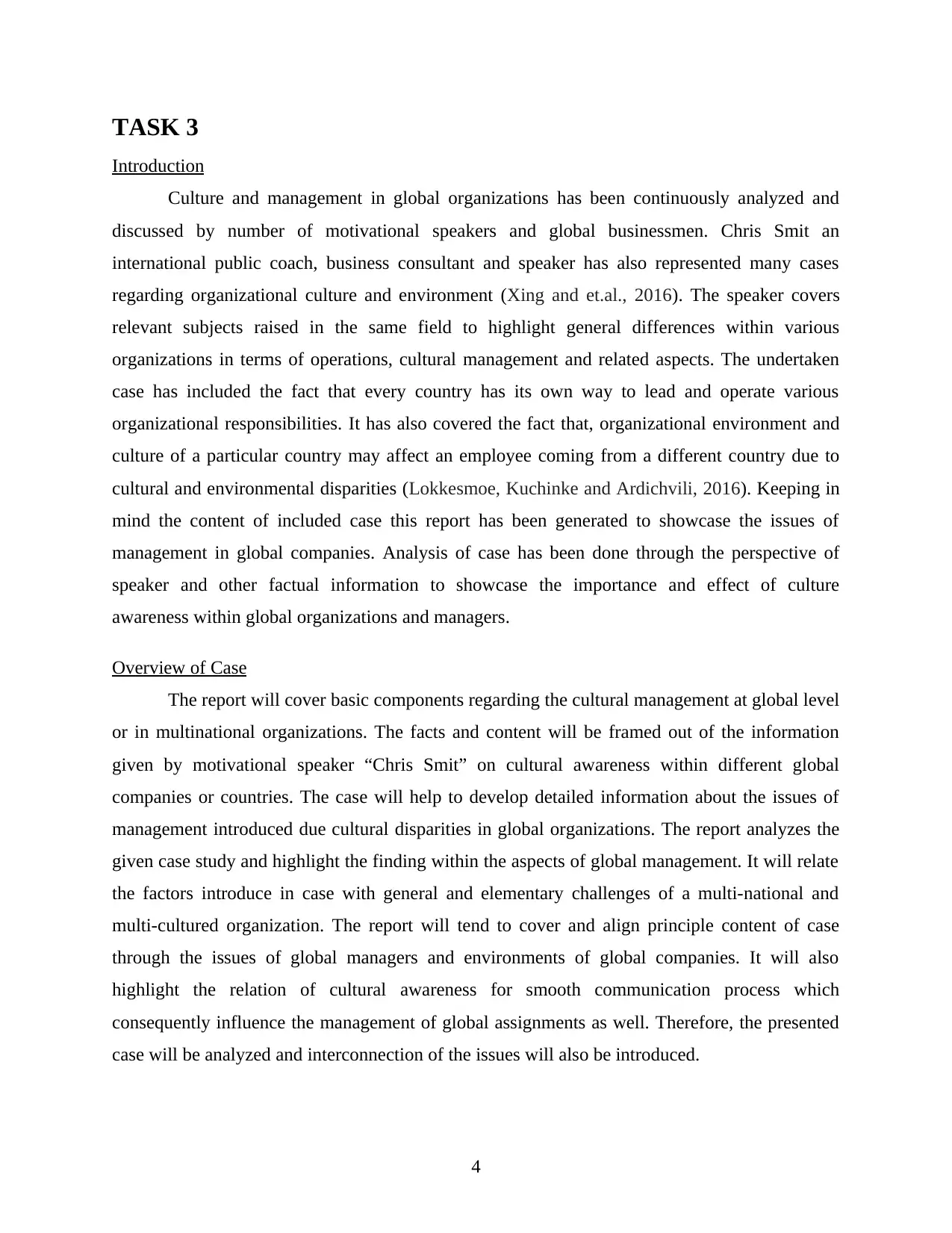
TASK 3
Introduction
Culture and management in global organizations has been continuously analyzed and
discussed by number of motivational speakers and global businessmen. Chris Smit an
international public coach, business consultant and speaker has also represented many cases
regarding organizational culture and environment (Xing and et.al., 2016). The speaker covers
relevant subjects raised in the same field to highlight general differences within various
organizations in terms of operations, cultural management and related aspects. The undertaken
case has included the fact that every country has its own way to lead and operate various
organizational responsibilities. It has also covered the fact that, organizational environment and
culture of a particular country may affect an employee coming from a different country due to
cultural and environmental disparities (Lokkesmoe, Kuchinke and Ardichvili, 2016). Keeping in
mind the content of included case this report has been generated to showcase the issues of
management in global companies. Analysis of case has been done through the perspective of
speaker and other factual information to showcase the importance and effect of culture
awareness within global organizations and managers.
Overview of Case
The report will cover basic components regarding the cultural management at global level
or in multinational organizations. The facts and content will be framed out of the information
given by motivational speaker “Chris Smit” on cultural awareness within different global
companies or countries. The case will help to develop detailed information about the issues of
management introduced due cultural disparities in global organizations. The report analyzes the
given case study and highlight the finding within the aspects of global management. It will relate
the factors introduce in case with general and elementary challenges of a multi-national and
multi-cultured organization. The report will tend to cover and align principle content of case
through the issues of global managers and environments of global companies. It will also
highlight the relation of cultural awareness for smooth communication process which
consequently influence the management of global assignments as well. Therefore, the presented
case will be analyzed and interconnection of the issues will also be introduced.
4
Introduction
Culture and management in global organizations has been continuously analyzed and
discussed by number of motivational speakers and global businessmen. Chris Smit an
international public coach, business consultant and speaker has also represented many cases
regarding organizational culture and environment (Xing and et.al., 2016). The speaker covers
relevant subjects raised in the same field to highlight general differences within various
organizations in terms of operations, cultural management and related aspects. The undertaken
case has included the fact that every country has its own way to lead and operate various
organizational responsibilities. It has also covered the fact that, organizational environment and
culture of a particular country may affect an employee coming from a different country due to
cultural and environmental disparities (Lokkesmoe, Kuchinke and Ardichvili, 2016). Keeping in
mind the content of included case this report has been generated to showcase the issues of
management in global companies. Analysis of case has been done through the perspective of
speaker and other factual information to showcase the importance and effect of culture
awareness within global organizations and managers.
Overview of Case
The report will cover basic components regarding the cultural management at global level
or in multinational organizations. The facts and content will be framed out of the information
given by motivational speaker “Chris Smit” on cultural awareness within different global
companies or countries. The case will help to develop detailed information about the issues of
management introduced due cultural disparities in global organizations. The report analyzes the
given case study and highlight the finding within the aspects of global management. It will relate
the factors introduce in case with general and elementary challenges of a multi-national and
multi-cultured organization. The report will tend to cover and align principle content of case
through the issues of global managers and environments of global companies. It will also
highlight the relation of cultural awareness for smooth communication process which
consequently influence the management of global assignments as well. Therefore, the presented
case will be analyzed and interconnection of the issues will also be introduced.
4
⊘ This is a preview!⊘
Do you want full access?
Subscribe today to unlock all pages.

Trusted by 1+ million students worldwide
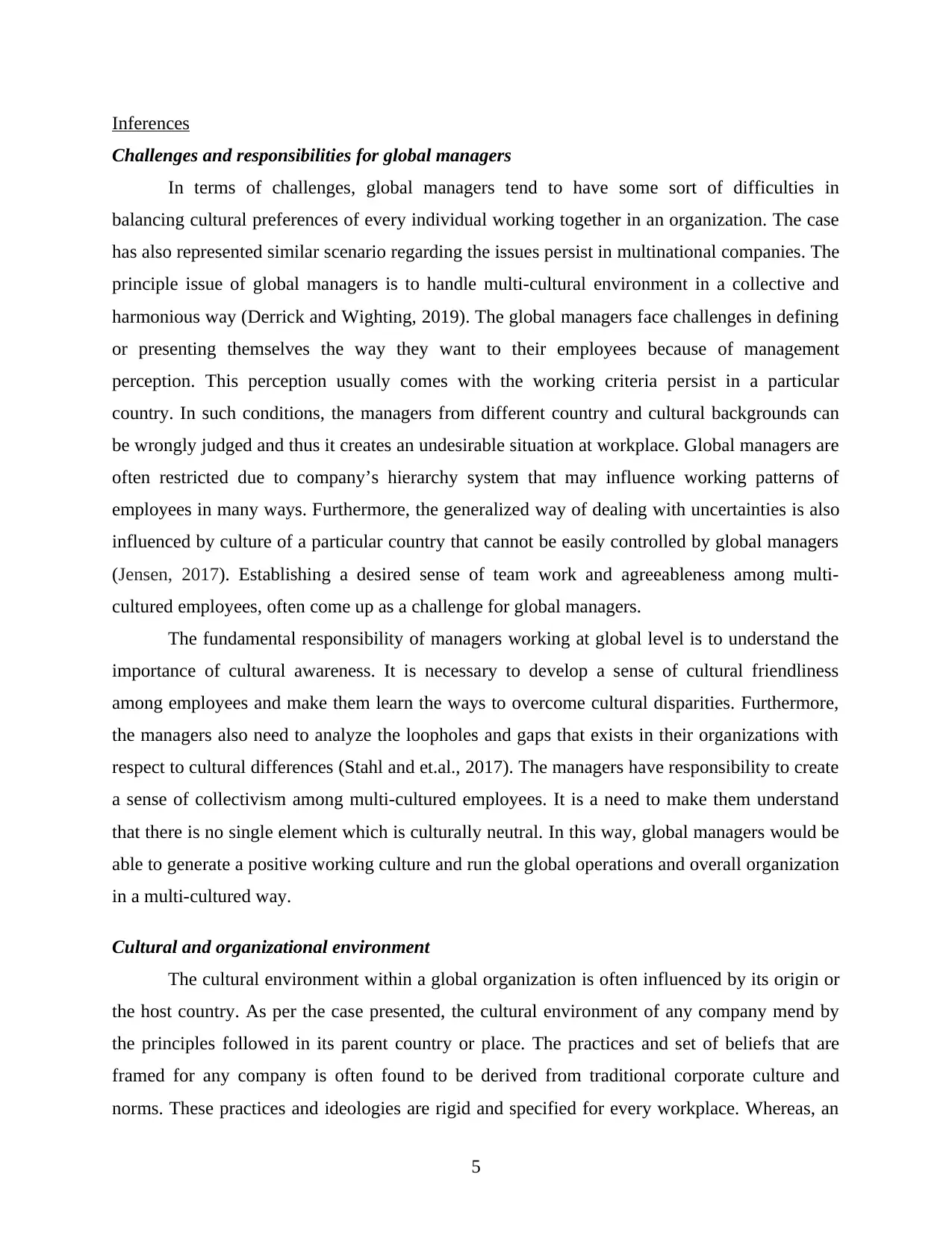
Inferences
Challenges and responsibilities for global managers
In terms of challenges, global managers tend to have some sort of difficulties in
balancing cultural preferences of every individual working together in an organization. The case
has also represented similar scenario regarding the issues persist in multinational companies. The
principle issue of global managers is to handle multi-cultural environment in a collective and
harmonious way (Derrick and Wighting, 2019). The global managers face challenges in defining
or presenting themselves the way they want to their employees because of management
perception. This perception usually comes with the working criteria persist in a particular
country. In such conditions, the managers from different country and cultural backgrounds can
be wrongly judged and thus it creates an undesirable situation at workplace. Global managers are
often restricted due to company’s hierarchy system that may influence working patterns of
employees in many ways. Furthermore, the generalized way of dealing with uncertainties is also
influenced by culture of a particular country that cannot be easily controlled by global managers
(Jensen, 2017). Establishing a desired sense of team work and agreeableness among multi-
cultured employees, often come up as a challenge for global managers.
The fundamental responsibility of managers working at global level is to understand the
importance of cultural awareness. It is necessary to develop a sense of cultural friendliness
among employees and make them learn the ways to overcome cultural disparities. Furthermore,
the managers also need to analyze the loopholes and gaps that exists in their organizations with
respect to cultural differences (Stahl and et.al., 2017). The managers have responsibility to create
a sense of collectivism among multi-cultured employees. It is a need to make them understand
that there is no single element which is culturally neutral. In this way, global managers would be
able to generate a positive working culture and run the global operations and overall organization
in a multi-cultured way.
Cultural and organizational environment
The cultural environment within a global organization is often influenced by its origin or
the host country. As per the case presented, the cultural environment of any company mend by
the principles followed in its parent country or place. The practices and set of beliefs that are
framed for any company is often found to be derived from traditional corporate culture and
norms. These practices and ideologies are rigid and specified for every workplace. Whereas, an
5
Challenges and responsibilities for global managers
In terms of challenges, global managers tend to have some sort of difficulties in
balancing cultural preferences of every individual working together in an organization. The case
has also represented similar scenario regarding the issues persist in multinational companies. The
principle issue of global managers is to handle multi-cultural environment in a collective and
harmonious way (Derrick and Wighting, 2019). The global managers face challenges in defining
or presenting themselves the way they want to their employees because of management
perception. This perception usually comes with the working criteria persist in a particular
country. In such conditions, the managers from different country and cultural backgrounds can
be wrongly judged and thus it creates an undesirable situation at workplace. Global managers are
often restricted due to company’s hierarchy system that may influence working patterns of
employees in many ways. Furthermore, the generalized way of dealing with uncertainties is also
influenced by culture of a particular country that cannot be easily controlled by global managers
(Jensen, 2017). Establishing a desired sense of team work and agreeableness among multi-
cultured employees, often come up as a challenge for global managers.
The fundamental responsibility of managers working at global level is to understand the
importance of cultural awareness. It is necessary to develop a sense of cultural friendliness
among employees and make them learn the ways to overcome cultural disparities. Furthermore,
the managers also need to analyze the loopholes and gaps that exists in their organizations with
respect to cultural differences (Stahl and et.al., 2017). The managers have responsibility to create
a sense of collectivism among multi-cultured employees. It is a need to make them understand
that there is no single element which is culturally neutral. In this way, global managers would be
able to generate a positive working culture and run the global operations and overall organization
in a multi-cultured way.
Cultural and organizational environment
The cultural environment within a global organization is often influenced by its origin or
the host country. As per the case presented, the cultural environment of any company mend by
the principles followed in its parent country or place. The practices and set of beliefs that are
framed for any company is often found to be derived from traditional corporate culture and
norms. These practices and ideologies are rigid and specified for every workplace. Whereas, an
5
Paraphrase This Document
Need a fresh take? Get an instant paraphrase of this document with our AI Paraphraser
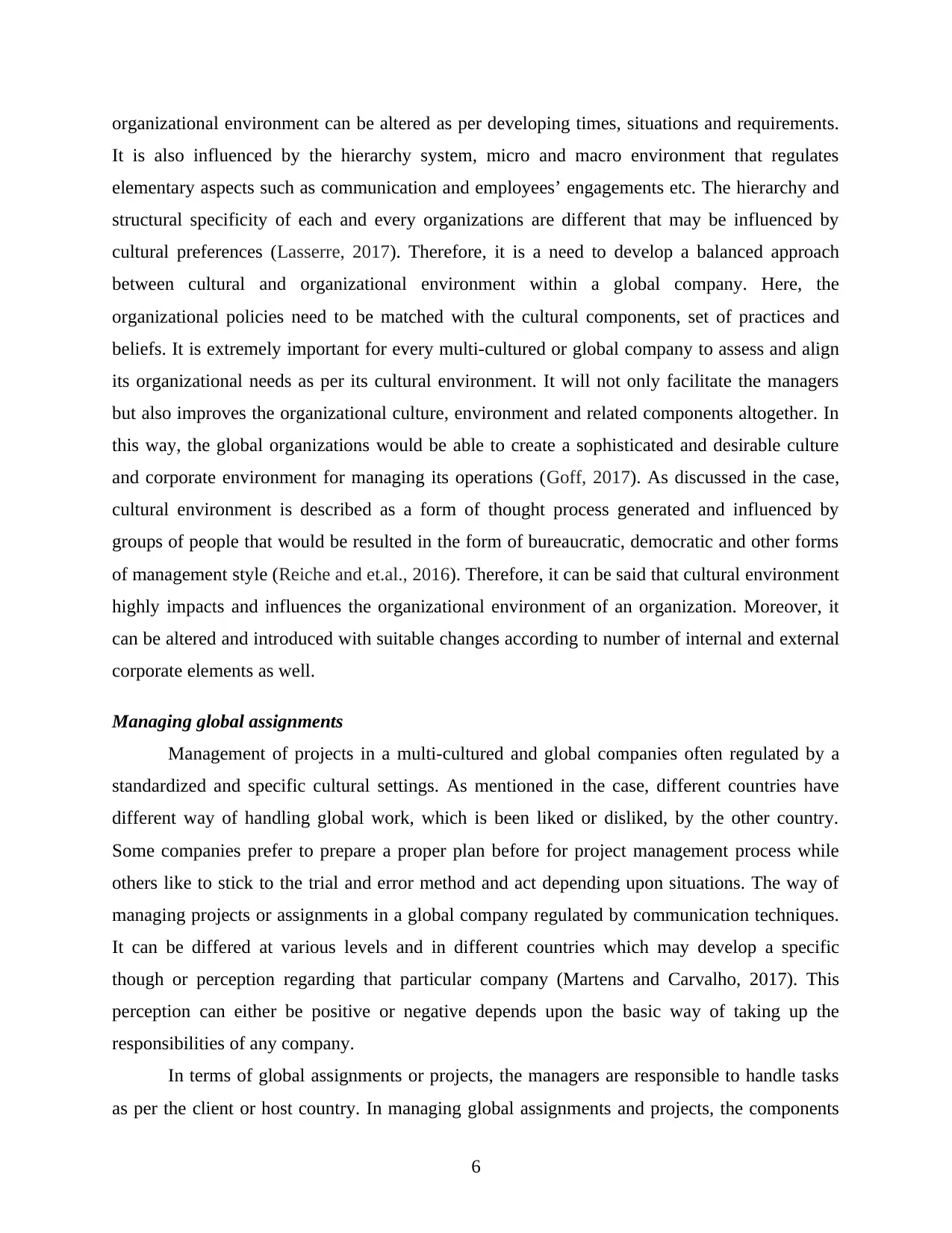
organizational environment can be altered as per developing times, situations and requirements.
It is also influenced by the hierarchy system, micro and macro environment that regulates
elementary aspects such as communication and employees’ engagements etc. The hierarchy and
structural specificity of each and every organizations are different that may be influenced by
cultural preferences (Lasserre, 2017). Therefore, it is a need to develop a balanced approach
between cultural and organizational environment within a global company. Here, the
organizational policies need to be matched with the cultural components, set of practices and
beliefs. It is extremely important for every multi-cultured or global company to assess and align
its organizational needs as per its cultural environment. It will not only facilitate the managers
but also improves the organizational culture, environment and related components altogether. In
this way, the global organizations would be able to create a sophisticated and desirable culture
and corporate environment for managing its operations (Goff, 2017). As discussed in the case,
cultural environment is described as a form of thought process generated and influenced by
groups of people that would be resulted in the form of bureaucratic, democratic and other forms
of management style (Reiche and et.al., 2016). Therefore, it can be said that cultural environment
highly impacts and influences the organizational environment of an organization. Moreover, it
can be altered and introduced with suitable changes according to number of internal and external
corporate elements as well.
Managing global assignments
Management of projects in a multi-cultured and global companies often regulated by a
standardized and specific cultural settings. As mentioned in the case, different countries have
different way of handling global work, which is been liked or disliked, by the other country.
Some companies prefer to prepare a proper plan before for project management process while
others like to stick to the trial and error method and act depending upon situations. The way of
managing projects or assignments in a global company regulated by communication techniques.
It can be differed at various levels and in different countries which may develop a specific
though or perception regarding that particular company (Martens and Carvalho, 2017). This
perception can either be positive or negative depends upon the basic way of taking up the
responsibilities of any company.
In terms of global assignments or projects, the managers are responsible to handle tasks
as per the client or host country. In managing global assignments and projects, the components
6
It is also influenced by the hierarchy system, micro and macro environment that regulates
elementary aspects such as communication and employees’ engagements etc. The hierarchy and
structural specificity of each and every organizations are different that may be influenced by
cultural preferences (Lasserre, 2017). Therefore, it is a need to develop a balanced approach
between cultural and organizational environment within a global company. Here, the
organizational policies need to be matched with the cultural components, set of practices and
beliefs. It is extremely important for every multi-cultured or global company to assess and align
its organizational needs as per its cultural environment. It will not only facilitate the managers
but also improves the organizational culture, environment and related components altogether. In
this way, the global organizations would be able to create a sophisticated and desirable culture
and corporate environment for managing its operations (Goff, 2017). As discussed in the case,
cultural environment is described as a form of thought process generated and influenced by
groups of people that would be resulted in the form of bureaucratic, democratic and other forms
of management style (Reiche and et.al., 2016). Therefore, it can be said that cultural environment
highly impacts and influences the organizational environment of an organization. Moreover, it
can be altered and introduced with suitable changes according to number of internal and external
corporate elements as well.
Managing global assignments
Management of projects in a multi-cultured and global companies often regulated by a
standardized and specific cultural settings. As mentioned in the case, different countries have
different way of handling global work, which is been liked or disliked, by the other country.
Some companies prefer to prepare a proper plan before for project management process while
others like to stick to the trial and error method and act depending upon situations. The way of
managing projects or assignments in a global company regulated by communication techniques.
It can be differed at various levels and in different countries which may develop a specific
though or perception regarding that particular company (Martens and Carvalho, 2017). This
perception can either be positive or negative depends upon the basic way of taking up the
responsibilities of any company.
In terms of global assignments or projects, the managers are responsible to handle tasks
as per the client or host country. In managing global assignments and projects, the components
6
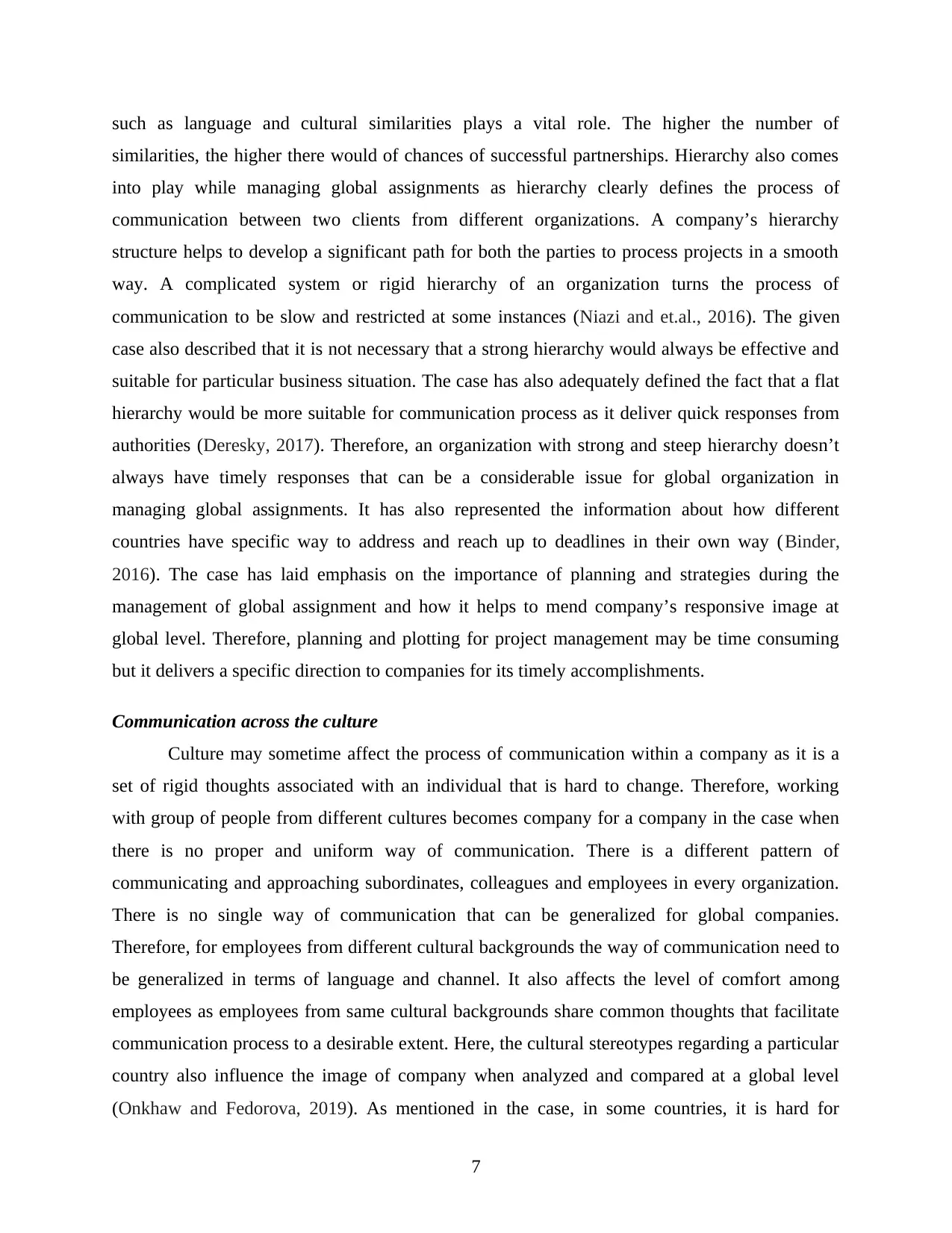
such as language and cultural similarities plays a vital role. The higher the number of
similarities, the higher there would of chances of successful partnerships. Hierarchy also comes
into play while managing global assignments as hierarchy clearly defines the process of
communication between two clients from different organizations. A company’s hierarchy
structure helps to develop a significant path for both the parties to process projects in a smooth
way. A complicated system or rigid hierarchy of an organization turns the process of
communication to be slow and restricted at some instances (Niazi and et.al., 2016). The given
case also described that it is not necessary that a strong hierarchy would always be effective and
suitable for particular business situation. The case has also adequately defined the fact that a flat
hierarchy would be more suitable for communication process as it deliver quick responses from
authorities (Deresky, 2017). Therefore, an organization with strong and steep hierarchy doesn’t
always have timely responses that can be a considerable issue for global organization in
managing global assignments. It has also represented the information about how different
countries have specific way to address and reach up to deadlines in their own way (Binder,
2016). The case has laid emphasis on the importance of planning and strategies during the
management of global assignment and how it helps to mend company’s responsive image at
global level. Therefore, planning and plotting for project management may be time consuming
but it delivers a specific direction to companies for its timely accomplishments.
Communication across the culture
Culture may sometime affect the process of communication within a company as it is a
set of rigid thoughts associated with an individual that is hard to change. Therefore, working
with group of people from different cultures becomes company for a company in the case when
there is no proper and uniform way of communication. There is a different pattern of
communicating and approaching subordinates, colleagues and employees in every organization.
There is no single way of communication that can be generalized for global companies.
Therefore, for employees from different cultural backgrounds the way of communication need to
be generalized in terms of language and channel. It also affects the level of comfort among
employees as employees from same cultural backgrounds share common thoughts that facilitate
communication process to a desirable extent. Here, the cultural stereotypes regarding a particular
country also influence the image of company when analyzed and compared at a global level
(Onkhaw and Fedorova, 2019). As mentioned in the case, in some countries, it is hard for
7
similarities, the higher there would of chances of successful partnerships. Hierarchy also comes
into play while managing global assignments as hierarchy clearly defines the process of
communication between two clients from different organizations. A company’s hierarchy
structure helps to develop a significant path for both the parties to process projects in a smooth
way. A complicated system or rigid hierarchy of an organization turns the process of
communication to be slow and restricted at some instances (Niazi and et.al., 2016). The given
case also described that it is not necessary that a strong hierarchy would always be effective and
suitable for particular business situation. The case has also adequately defined the fact that a flat
hierarchy would be more suitable for communication process as it deliver quick responses from
authorities (Deresky, 2017). Therefore, an organization with strong and steep hierarchy doesn’t
always have timely responses that can be a considerable issue for global organization in
managing global assignments. It has also represented the information about how different
countries have specific way to address and reach up to deadlines in their own way (Binder,
2016). The case has laid emphasis on the importance of planning and strategies during the
management of global assignment and how it helps to mend company’s responsive image at
global level. Therefore, planning and plotting for project management may be time consuming
but it delivers a specific direction to companies for its timely accomplishments.
Communication across the culture
Culture may sometime affect the process of communication within a company as it is a
set of rigid thoughts associated with an individual that is hard to change. Therefore, working
with group of people from different cultures becomes company for a company in the case when
there is no proper and uniform way of communication. There is a different pattern of
communicating and approaching subordinates, colleagues and employees in every organization.
There is no single way of communication that can be generalized for global companies.
Therefore, for employees from different cultural backgrounds the way of communication need to
be generalized in terms of language and channel. It also affects the level of comfort among
employees as employees from same cultural backgrounds share common thoughts that facilitate
communication process to a desirable extent. Here, the cultural stereotypes regarding a particular
country also influence the image of company when analyzed and compared at a global level
(Onkhaw and Fedorova, 2019). As mentioned in the case, in some countries, it is hard for
7
⊘ This is a preview!⊘
Do you want full access?
Subscribe today to unlock all pages.

Trusted by 1+ million students worldwide
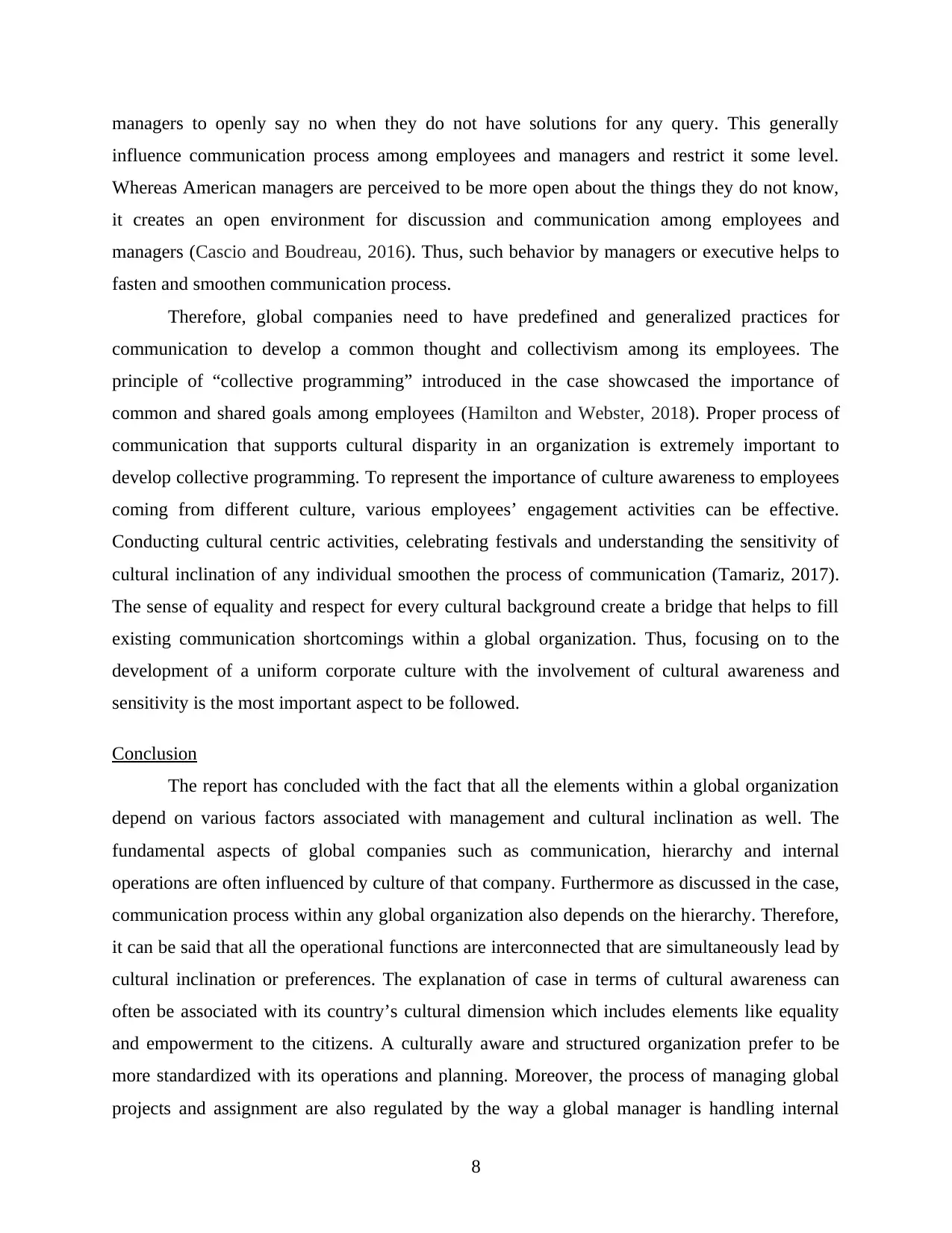
managers to openly say no when they do not have solutions for any query. This generally
influence communication process among employees and managers and restrict it some level.
Whereas American managers are perceived to be more open about the things they do not know,
it creates an open environment for discussion and communication among employees and
managers (Cascio and Boudreau, 2016). Thus, such behavior by managers or executive helps to
fasten and smoothen communication process.
Therefore, global companies need to have predefined and generalized practices for
communication to develop a common thought and collectivism among its employees. The
principle of “collective programming” introduced in the case showcased the importance of
common and shared goals among employees (Hamilton and Webster, 2018). Proper process of
communication that supports cultural disparity in an organization is extremely important to
develop collective programming. To represent the importance of culture awareness to employees
coming from different culture, various employees’ engagement activities can be effective.
Conducting cultural centric activities, celebrating festivals and understanding the sensitivity of
cultural inclination of any individual smoothen the process of communication (Tamariz, 2017).
The sense of equality and respect for every cultural background create a bridge that helps to fill
existing communication shortcomings within a global organization. Thus, focusing on to the
development of a uniform corporate culture with the involvement of cultural awareness and
sensitivity is the most important aspect to be followed.
Conclusion
The report has concluded with the fact that all the elements within a global organization
depend on various factors associated with management and cultural inclination as well. The
fundamental aspects of global companies such as communication, hierarchy and internal
operations are often influenced by culture of that company. Furthermore as discussed in the case,
communication process within any global organization also depends on the hierarchy. Therefore,
it can be said that all the operational functions are interconnected that are simultaneously lead by
cultural inclination or preferences. The explanation of case in terms of cultural awareness can
often be associated with its country’s cultural dimension which includes elements like equality
and empowerment to the citizens. A culturally aware and structured organization prefer to be
more standardized with its operations and planning. Moreover, the process of managing global
projects and assignment are also regulated by the way a global manager is handling internal
8
influence communication process among employees and managers and restrict it some level.
Whereas American managers are perceived to be more open about the things they do not know,
it creates an open environment for discussion and communication among employees and
managers (Cascio and Boudreau, 2016). Thus, such behavior by managers or executive helps to
fasten and smoothen communication process.
Therefore, global companies need to have predefined and generalized practices for
communication to develop a common thought and collectivism among its employees. The
principle of “collective programming” introduced in the case showcased the importance of
common and shared goals among employees (Hamilton and Webster, 2018). Proper process of
communication that supports cultural disparity in an organization is extremely important to
develop collective programming. To represent the importance of culture awareness to employees
coming from different culture, various employees’ engagement activities can be effective.
Conducting cultural centric activities, celebrating festivals and understanding the sensitivity of
cultural inclination of any individual smoothen the process of communication (Tamariz, 2017).
The sense of equality and respect for every cultural background create a bridge that helps to fill
existing communication shortcomings within a global organization. Thus, focusing on to the
development of a uniform corporate culture with the involvement of cultural awareness and
sensitivity is the most important aspect to be followed.
Conclusion
The report has concluded with the fact that all the elements within a global organization
depend on various factors associated with management and cultural inclination as well. The
fundamental aspects of global companies such as communication, hierarchy and internal
operations are often influenced by culture of that company. Furthermore as discussed in the case,
communication process within any global organization also depends on the hierarchy. Therefore,
it can be said that all the operational functions are interconnected that are simultaneously lead by
cultural inclination or preferences. The explanation of case in terms of cultural awareness can
often be associated with its country’s cultural dimension which includes elements like equality
and empowerment to the citizens. A culturally aware and structured organization prefer to be
more standardized with its operations and planning. Moreover, the process of managing global
projects and assignment are also regulated by the way a global manager is handling internal
8
Paraphrase This Document
Need a fresh take? Get an instant paraphrase of this document with our AI Paraphraser
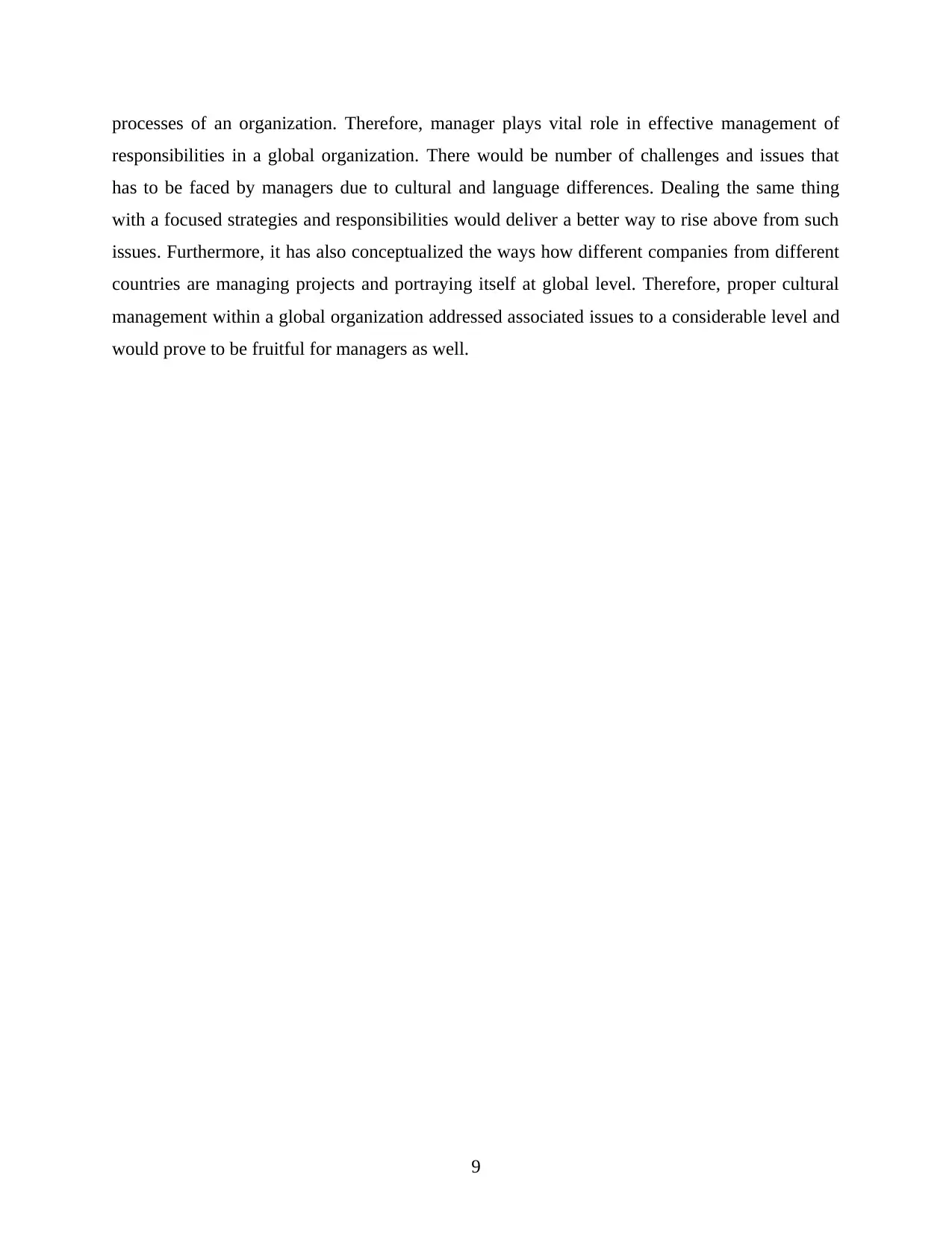
processes of an organization. Therefore, manager plays vital role in effective management of
responsibilities in a global organization. There would be number of challenges and issues that
has to be faced by managers due to cultural and language differences. Dealing the same thing
with a focused strategies and responsibilities would deliver a better way to rise above from such
issues. Furthermore, it has also conceptualized the ways how different companies from different
countries are managing projects and portraying itself at global level. Therefore, proper cultural
management within a global organization addressed associated issues to a considerable level and
would prove to be fruitful for managers as well.
9
responsibilities in a global organization. There would be number of challenges and issues that
has to be faced by managers due to cultural and language differences. Dealing the same thing
with a focused strategies and responsibilities would deliver a better way to rise above from such
issues. Furthermore, it has also conceptualized the ways how different companies from different
countries are managing projects and portraying itself at global level. Therefore, proper cultural
management within a global organization addressed associated issues to a considerable level and
would prove to be fruitful for managers as well.
9
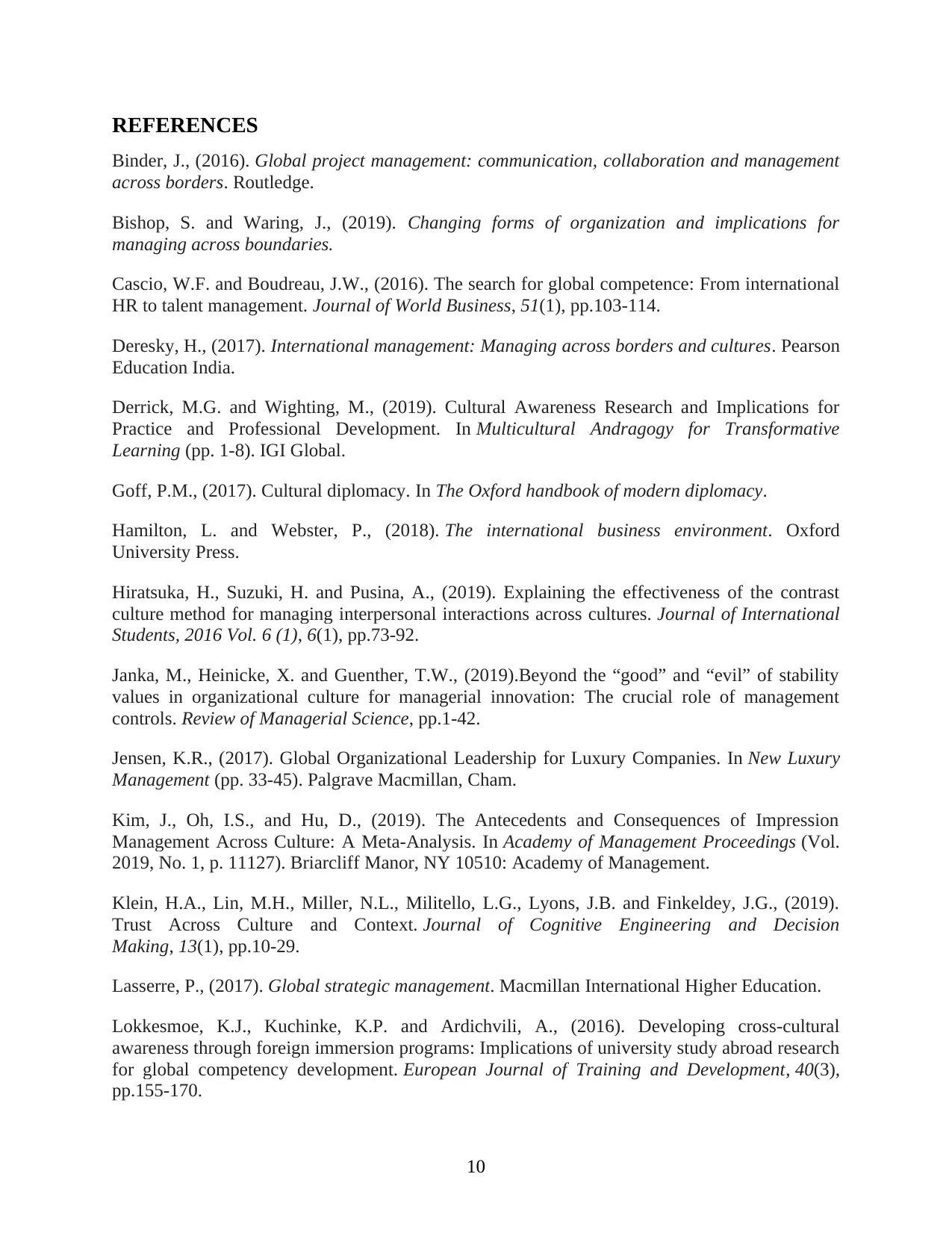
REFERENCES
Binder, J., (2016). Global project management: communication, collaboration and management
across borders. Routledge.
Bishop, S. and Waring, J., (2019). Changing forms of organization and implications for
managing across boundaries.
Cascio, W.F. and Boudreau, J.W., (2016). The search for global competence: From international
HR to talent management. Journal of World Business, 51(1), pp.103-114.
Deresky, H., (2017). International management: Managing across borders and cultures. Pearson
Education India.
Derrick, M.G. and Wighting, M., (2019). Cultural Awareness Research and Implications for
Practice and Professional Development. In Multicultural Andragogy for Transformative
Learning (pp. 1-8). IGI Global.
Goff, P.M., (2017). Cultural diplomacy. In The Oxford handbook of modern diplomacy.
Hamilton, L. and Webster, P., (2018). The international business environment. Oxford
University Press.
Hiratsuka, H., Suzuki, H. and Pusina, A., (2019). Explaining the effectiveness of the contrast
culture method for managing interpersonal interactions across cultures. Journal of International
Students, 2016 Vol. 6 (1), 6(1), pp.73-92.
Janka, M., Heinicke, X. and Guenther, T.W., (2019).Beyond the “good” and “evil” of stability
values in organizational culture for managerial innovation: The crucial role of management
controls. Review of Managerial Science, pp.1-42.
Jensen, K.R., (2017). Global Organizational Leadership for Luxury Companies. In New Luxury
Management (pp. 33-45). Palgrave Macmillan, Cham.
Kim, J., Oh, I.S., and Hu, D., (2019). The Antecedents and Consequences of Impression
Management Across Culture: A Meta-Analysis. In Academy of Management Proceedings (Vol.
2019, No. 1, p. 11127). Briarcliff Manor, NY 10510: Academy of Management.
Klein, H.A., Lin, M.H., Miller, N.L., Militello, L.G., Lyons, J.B. and Finkeldey, J.G., (2019).
Trust Across Culture and Context. Journal of Cognitive Engineering and Decision
Making, 13(1), pp.10-29.
Lasserre, P., (2017). Global strategic management. Macmillan International Higher Education.
Lokkesmoe, K.J., Kuchinke, K.P. and Ardichvili, A., (2016). Developing cross-cultural
awareness through foreign immersion programs: Implications of university study abroad research
for global competency development. European Journal of Training and Development, 40(3),
pp.155-170.
10
Binder, J., (2016). Global project management: communication, collaboration and management
across borders. Routledge.
Bishop, S. and Waring, J., (2019). Changing forms of organization and implications for
managing across boundaries.
Cascio, W.F. and Boudreau, J.W., (2016). The search for global competence: From international
HR to talent management. Journal of World Business, 51(1), pp.103-114.
Deresky, H., (2017). International management: Managing across borders and cultures. Pearson
Education India.
Derrick, M.G. and Wighting, M., (2019). Cultural Awareness Research and Implications for
Practice and Professional Development. In Multicultural Andragogy for Transformative
Learning (pp. 1-8). IGI Global.
Goff, P.M., (2017). Cultural diplomacy. In The Oxford handbook of modern diplomacy.
Hamilton, L. and Webster, P., (2018). The international business environment. Oxford
University Press.
Hiratsuka, H., Suzuki, H. and Pusina, A., (2019). Explaining the effectiveness of the contrast
culture method for managing interpersonal interactions across cultures. Journal of International
Students, 2016 Vol. 6 (1), 6(1), pp.73-92.
Janka, M., Heinicke, X. and Guenther, T.W., (2019).Beyond the “good” and “evil” of stability
values in organizational culture for managerial innovation: The crucial role of management
controls. Review of Managerial Science, pp.1-42.
Jensen, K.R., (2017). Global Organizational Leadership for Luxury Companies. In New Luxury
Management (pp. 33-45). Palgrave Macmillan, Cham.
Kim, J., Oh, I.S., and Hu, D., (2019). The Antecedents and Consequences of Impression
Management Across Culture: A Meta-Analysis. In Academy of Management Proceedings (Vol.
2019, No. 1, p. 11127). Briarcliff Manor, NY 10510: Academy of Management.
Klein, H.A., Lin, M.H., Miller, N.L., Militello, L.G., Lyons, J.B. and Finkeldey, J.G., (2019).
Trust Across Culture and Context. Journal of Cognitive Engineering and Decision
Making, 13(1), pp.10-29.
Lasserre, P., (2017). Global strategic management. Macmillan International Higher Education.
Lokkesmoe, K.J., Kuchinke, K.P. and Ardichvili, A., (2016). Developing cross-cultural
awareness through foreign immersion programs: Implications of university study abroad research
for global competency development. European Journal of Training and Development, 40(3),
pp.155-170.
10
⊘ This is a preview!⊘
Do you want full access?
Subscribe today to unlock all pages.

Trusted by 1+ million students worldwide
1 out of 13
Related Documents
Your All-in-One AI-Powered Toolkit for Academic Success.
+13062052269
info@desklib.com
Available 24*7 on WhatsApp / Email
![[object Object]](/_next/static/media/star-bottom.7253800d.svg)
Unlock your academic potential
Copyright © 2020–2025 A2Z Services. All Rights Reserved. Developed and managed by ZUCOL.




